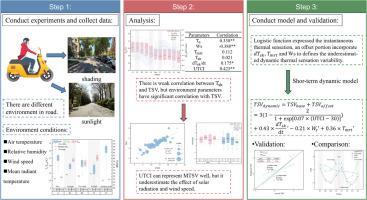冬季波动太阳辐射下电动自行车骑行者动态热感觉预测方法
IF 7.6
1区 工程技术
Q1 CONSTRUCTION & BUILDING TECHNOLOGY
引用次数: 0
摘要
电动自行车(e-bikes)是城市通勤的必需品。然而,由于风速增加和太阳辐射波动,车手在保持热舒适性方面面临着重大挑战。为夏季设计的城市遮阳可以减少有益的冬季阳光照射,导致寒冷不适,特别是对骑电动自行车的人来说。本研究旨在探讨冬季电动自行车骑行者的动态生理和感知热反应特征,并建立动态热感觉模型。在初冬的南京,25名被试沿着校园道路进行了模拟波动太阳照射的实验。收集了气象数据、生理测量和热感知反应。研究结果表明,在冬季,高风速经常会给骑电动自行车的人带来寒冷不适。即使在强风条件下,太阳辐射也能部分抵消这种冷却效果。观察到明显的预期效应,这限制了皮肤温度变化率预测电动自行车骑手热感觉的解释力。通用热气候指数(UTCI)提供了一个可靠的热感觉估计,但往往低估了风速和太阳辐射对电动自行车骑手的耦合影响。为了解决这一限制,研究人员开发了一个新的动态模型,该模型集成了来自UTCI的基本分量和包含皮肤温度、平均辐射温度和风速变化率的偏移分量。该研究促进了对电动自行车骑行者热舒适的理解,有助于优化以健康为导向的低碳出行系统。本文章由计算机程序翻译,如有差异,请以英文原文为准。

A method of predicting dynamic thermal sensation for e-bike riders under fluctuating solar radiation in winter
Electric bikes (e-bikes) are essential for urban commuting. However, riders face significant challenges in maintaining thermal comfort due to heightened wind speed and fluctuating solar radiation. Urban shading designed for summer can reduce beneficial winter solar exposure, leading to cold discomfort, particularly for e-bike riders. This study aims to investigate the dynamic physiological and perceptual thermal response characteristics and develop a dynamic thermal sensation model for e-bike riders in winter. An experiment simulating fluctuating solar exposure was conducted with 25 participants along a campus road in Nanjing during early winter. Meteorological data, physiological measurements and thermal perception responses were collected. The results show that high wind speeds frequently cause cold discomfort for e-bike riders during winter. Solar radiation can partially counteract this cooling effect, even under strong wind conditions. A pronounced anticipatory effect was observed, which limits the explanatory power of the rate of change in skin temperature for predicting e-bike riders’ thermal sensation. The Universal Thermal Climate Index (UTCI) provides a reliable estimation of thermal sensation but tends to underestimate the coupled effects of wind speed and solar radiation on e-bike riders. To address this limitation, a new dynamic model was developed, integrating a base component derived from UTCI and an offset component incorporating the rate of change in skin temperature, mean radiant temperature, and wind speed. This study advances the understanding of thermal comfort for e-bike riders and contributes to optimizing a health-oriented low-carbon travel system.
求助全文
通过发布文献求助,成功后即可免费获取论文全文。
去求助
来源期刊

Building and Environment
工程技术-工程:环境
CiteScore
12.50
自引率
23.00%
发文量
1130
审稿时长
27 days
期刊介绍:
Building and Environment, an international journal, is dedicated to publishing original research papers, comprehensive review articles, editorials, and short communications in the fields of building science, urban physics, and human interaction with the indoor and outdoor built environment. The journal emphasizes innovative technologies and knowledge verified through measurement and analysis. It covers environmental performance across various spatial scales, from cities and communities to buildings and systems, fostering collaborative, multi-disciplinary research with broader significance.
 求助内容:
求助内容: 应助结果提醒方式:
应助结果提醒方式:


